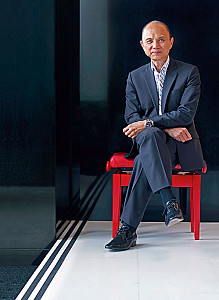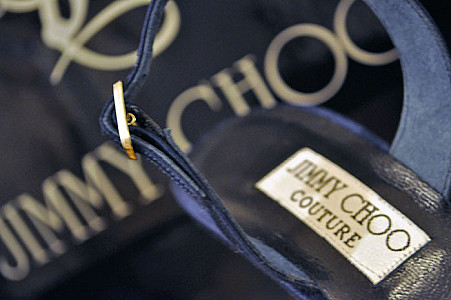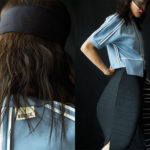The Chatty Professor

Checking some breaking news – are you buying back the Jimmy Choo London brand?
I am considering and working on it. The Malaysian government is being very supportive – as they have always been – and also, the general people’s opinions are encouraging. There was a radio show in Malaysia, post which there were so many messages of support for me to buy back the brand. It was quite moving.
A whopping figure of almost USD one billion is the brand’s current worth. Is it surreal having your name on something worth that much?
I am not so much into the numbers game, so the money part does not excite me as much as the creative part does. Sure, it’s great that the brand has made it this big and reached out to a global audience. But to me, all the business bits and negotiations are things that I have had to learn during all my years in my work field. Given the chance, I’d rather not have known anything about the math and been very happy just creating.
Surely you must have fine-tuned your business acumen by now?
Only to the point that’s necessary. I’m still the same person that I was when I’d started out. I feel best when I’m able to create something beautiful.
But being the ‘naïve creator’ is not recommended. Is that why, having family in business is important – to watch your back?
Yes, you need to have someone who you can trust supremely. I have my niece. She suddenly told me that she wanted to work with me, and I was happy to have her on board. She understands me the most, there’s a sort of wordless coordination. She looks into the business and management aspects of my couture brand. I rely on her for everything. Even though she’s my niece, I feel she’s more of a sister. I ask her for advice. She’s very mature.
Is couture shoemaking a joint design process with your customer? What if someone interferes too much?
Very much. I study them and their feet. I ask for what occasion, what dress they will wear, what colour, what are their material preferences – everything is noted. It’s a very interactive process. It has to be when you’re making something unique, specifically for a person. And when a customer is being too difficult, my niece steps in and handles everything beautifully.
How do you study feet? How much time do you require for a basic study?
A glance is enough to start with. For example, I can tell right now that you have trouble finding the right shoes for yourself, because your feet are narrow. We Asians are also used to open footwear, so our toes are wider spread. Europeans have more packed toes, as they mostly wear closed shoes. Also, most of us have one foot slightly larger than the other – the strong leg/ weak leg concept. If we analyse further, there are many more intricacies. A standard universal sizing system is not enough to provide people with footwear that is correct for them. Feet are all about non-specific shapes. To me, feet are characters.
Men designing women’s footwear – do you think they can get too fantastical or fetishist?
Why just footwear? Even in clothes, you have more men designing womenswear. Maybe we need more women in design. But in a couture shoe process, I customise the design according to a client’s personality and measurements, so even if I stretch my imagination, certain comfort or balance points are going to be according to their specifications, so the shoes should be a better experience to wear.
The couture experience versus luxury prêt, when price points are similar?
As someone who has to struggle with shoe purchases, you yourself will appreciate a product that is so personal, contouring you in a way that even the best made ready product from a luxury brand can’t. I bought a beautiful Armani suit recently – the best fabric, the finest finish, gorgeous design. But the suit I’m wearing right now – made to measure by a local tailor in Kuala Lumpur – works for me better, because it is shaped exactly according to my shape. Which one would I wear more, you tell me.
Shoemaking has been in your family. Were you pushed into it or naturally inclined?
Never pushed. I remember a particular incident that aroused my interest. I was a child then. A lady came to my father in Malaysia and ordered about 12 pairs of the same shoe design. She was a tightrope-walking artist, and required a unique design for grip and balance. Since she was going on tour, she wanted to stock extra pairs, and was confident only in the shoes made by my father. That kind of faith made me respect my father’s professional calibre. In those days you didn’t have so much machinery – only the basic sewing ones. I watched him make each shoe with his own hands – start to finish.
Is that why couture footwear became your calling?
My father taught me that all artists need to know their craft – the processes, the methods, the raw materials. I respect the traditions and the integrity of the older makers. You can only connect with something by touching, feeling and making it yourself. Today I’m fortunate to have a team that can craft designs for me, though I’m extremely involved in the process. But when I started, I had to do everything myself. And I am proud of that. Tomorrow, if a client orders and my people fall ill, I shall be able to handcraft a pair myself.
Is one’s relationship with their craft what keeps them grounded?
Yes. For me, it is also my deep faith in Buddhism. I am very religious, and have a temple for monks attached to my house in Malaysia. I follow the principles of my faith, and it teaches me that the universe is much larger than oneself. The headiness of my line of work is balanced by the guidance I receive from my spirituality. God also helps me through difficult and stressful times.
Being an ambassador for education – is this also your way to give back?
Certainly. But I also enjoy connecting with young people all over the world. Particularly in Asia, the youth is very much in touch with traditions, including crafts. It is important to have them conscious of their heritage; yet encourage them to open their mind. And also to understand that there are no short cuts to success; we all need to learn our craft and have a good foundation. I also learn immensely from my interactions with the youth. They keep me refreshed.
On a creative scale, how would you rate Asian students aspiring to pursue courses, for example, at a place like University of the Arts, London, when compared to their European counterparts?
They are evolving. As I said, they have a strong crafts heritage. In Europe, they can probably polish their technical skills a lot more, challenge home-learned perceptions and step out of their comfort zone. It would be wonderful to then see them apply everything together and create art that has history, craft, radical thought and technology – all together. More exchange programmes would give design students in Asia better exposure.
Any exchanges/scholarship opportunities that you are instrumental in?
I work very closely with the International School of Creative Arts at Fulmer, London (he is Honorary President) that guides its students from a pre-university level. It houses students from many countries. I also visit various Asian countries and meet students from different design schools regularly. It would be great if there are exchange programmes or scholarships for Asian students to ISCA or University of the Arts, London. Something will surely be organised in the future.
Related posts from Verve:
Verve Trending
Sorry. No data so far.
us on Facebook to stay updated with the latest trends






